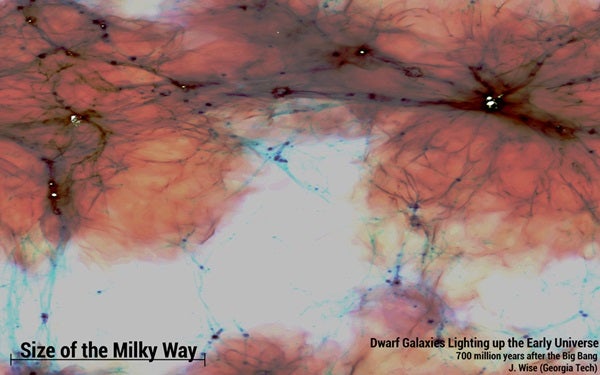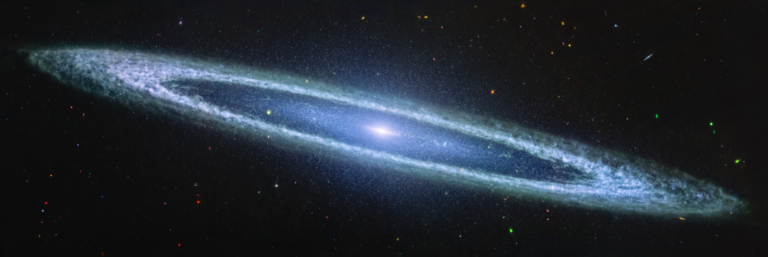Shortly after the Big Bang, the universe was ionized: Ordinary matter consisted of hydrogen with its positively charged protons stripped of their negatively charged electrons. Eventually, the universe cooled enough for electrons and protons to combine and form neutral hydrogen. This cool gas will eventually form the first stars in the universe, but for millions of years, there are no stars. Astronomers therefore aren’t able to see how the cosmos evolved during these “Dark Ages” using conventional telescopes. The light returned when newly forming stars and galaxies reionized the universe during the “epoch of reionization.”
Astronomers agree that the universe became fully reionized roughly 1 billion years after the Big Bang. About 200 million years after the birth of the cosmos, ultraviolet (UV) radiation from stars began to split neutral hydrogen into electrons and protons. It took another 800 million years to complete the process everywhere. This epoch of reionization marked the last major change to gas in the universe, and it remains ionized today, over 12 billion years later.
However, astronomers aren’t in agreement on which type of galaxies played the most important role in this process. Most have focused on large galaxies. The new study by researchers at the Georgia Institute of Technology and the San Diego Supercomputer Center indicates scientists should also focus on the smallest ones.
The researchers used computer simulations to demonstrate the faintest and smallest galaxies in the early universe were essential. These tiny galaxies, despite being 1,000 times smaller in mass and 30 times smaller in size than our Milky Way Galaxy, contributed nearly 30 percent of the UV light during this process. Other studies often ignore these small “dwarf” galaxies as they weren’t thought to form stars because the UV light from nearby larger galaxies was too strong and suppressed these tiny neighbors.
“It turns out these dwarf galaxies did form stars, usually in one burst, around 500 million years after the Big Bang,” said John Wise of the Georgia Institute of Technology in Atlanta. “The galaxies were small but so plentiful that they contributed a significant fraction of UV light in the reionization process.”
The team’s simulations modeled the flow of UV stellar light through the gas within galaxies as they formed. They found that the fraction of ionizing photons escaping into intergalactic space was 50 percent in small galaxies — more than 10 million solar masses. It was only 5 percent in larger galaxies — 300 million solar masses. This elevated fraction, combined with their high abundance, is exactly the reason why the faintest galaxies play an integral role during reionization.
“It’s very hard for UV light to escape galaxies because of the dense gas that fills them,” said Wise. “In small galaxies, there’s less gas between stars, making it easier for UV light to escape because it isn’t absorbed as quickly. Plus, supernova explosions can open up channels more easily in these tiny galaxies in which UV light can escape.”
The team’s simulation results provide a gradual timeline that tracks the progress of reionization over hundreds of millions of years. About 300 million years after the Big Bang, the universe was 20 percent ionized; it was 50 percent at 550 million years. The simulated universe was fully ionized at 860 million years after its creation.
“That such small galaxies could contribute so much to reionization is a real surprise,” said Michael Norman of the University of California, San Diego. “Once again, the supercomputer is teaching us something new and unexpected, something that will need to be factored into future studies of reionization.”
The research team expects to learn more about these faint galaxies when the next generation of telescopes is operational. For example, NASA’s James Webb Space Telescope, scheduled to launch in 2018, will be able to see them.










